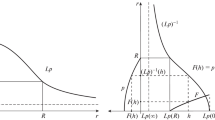Abstract
It was shown earlier that, in the range of rare collisions, transport equations for stellarators allow steady discontinuous solutions for the ambipolar electric field and for the plasma density and temperature gradients. Moreover, such solutions are non-single-valued; that is, their explicit form depends on the initial values of the ambipolar electric field. The time-independent transport equations are derived under the conventional quasineutrality condition; i.e., it is assumed that the electron and ion densities, N e and N i , are related by the relationship N e = ZN i (where Z is the ion charge number). In other words, the plasma charge density is assumed to be much less than the product e i N i . Under typical conditions, the corresponding inequality is satisfied by a large margin. However, if the electric field E has discontinuities, then it can be seen from the equation ▿·E = 4πρ that, at the discontinuity points, the charge density becomes infinite and the relationship N e = ZN i fails to hold, so it is necessary to replace it with N e = ZN i + ρ/e e . In the transport equations, this latter replacement produces additional terms, proportional to the second radial derivative of the field E. With these additional terms, the steady solutions are modified substantially. First, the ambipolar field and the derivatives of the density and temperatures all become continuous functions of the coordinates, a result that seems to be quite obvious. The second, not-so-obvious result is that the steady solutions become single-valued, i.e., independent of the initial values of the ambipolar electric field. It turns out that, in this case, two regimes are possible, depending on the values of the plasma parameters. In the first regime, the solution is unique and is independent of the initial conditions. In the second regime, two steady solutions can exist, depending on the initial conditions. One of the solution is similar to that obtained in the first regime, and the other differs from the first one both in the ambipolar field profile and in the dependence of the density and temperatures on the minor plasma radius. It cannot be excluded that different plasma confinement modes revealed in experiments are associated with the existence of such solutions.
Similar content being viewed by others
References
L. M. Kovrizhnykh, Zh. Éksp. Teor. Fiz. 56, 877 (1969) [Sov. Phys. JETP 29, 475 (1969)].
L. M. Kovrizhnykh, Fiz. Plazmy 31, 17 (2005) [Plasma Phys. Rep. 31, 14 (2005)].
L. M. Kovrizhnykh, Fiz. Plazmy 34, 1071 (2008) [Plasma Phys. Rep. 34, 991 (2008)].
F. Fujisawa, Plasma Phys. Controlled Fusion 45, R1 (1989).
L. M. Kovrizhnykh, Fiz. Plazmy 32, 1070 (2006) [Plasma Phys. Rep. 32, 988 (2006)].
L. M. Kovrizhnykh, Fiz. Plazmy 34, 579 (2008) [Plasma Phys. Rep. 34, 529 (2008)].
D. E. Hastings, Phys. Fluids 28, 334 (1985).
S. Toda and K. Itoh, Plasma Phys. Controlled Fusion 43, 629 (2001).
L. D. Landau and E. M. Lifshitz, Fluid Mechanics (Nauka, Moscow, 1986; Pergamon, Oxford, 1987).
A. P. Petrov, Extended Abstract of Doctoral Dissertation (Institute of Mathematical Modeling, Russian Academy of Sciences, Moscow, 2009).
Author information
Authors and Affiliations
Additional information
Original Russian Text © L.M. Kovrizhnykh, 2010, published in Fizika Plazmy, 2010, Vol. 36, No. 8, pp. 712–723.
Rights and permissions
About this article
Cite this article
Kovrizhnykh, L.M. Evolution of discontinuous solutions to transport equations in stellarators. Plasma Phys. Rep. 36, 665–675 (2010). https://doi.org/10.1134/S1063780X10080039
Received:
Published:
Issue Date:
DOI: https://doi.org/10.1134/S1063780X10080039




